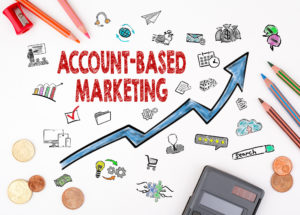In one of our recent blog post, we discussed how predictive analytics can help you develop a model for identifying current and potential customers who are most likely to buy your product. However, for that information to be useful, you need to take the data insights and develop a cohesive strategy to reach those customers. That’s where account-based marketing (ABM) comes in.
What is ABM?
Primarily used for B2B models, ABM pursues select accounts using a strategic one-to-one marketing approach. Rather than making a broad attempt to appeal to the masses, ABM personalizes the sales and marketing process by using an individualized strategy to target accounts and their key decision makers. Your strategy and messaging adjusts for each account and is tailored to their unique needs and attributes. Because of this, your efforts are more likely to resonate with your prospective customers since your messaging is customized for them.
Using Your Predictive Model
Identifying your target customers is the foundational step to a successful ABM strategy. That’s where big data and predictive analytics can help. Your predictive model should have helped you identify the profile of your ideal customer so that you can identify new customers to target or current customers that may need additional products or services. Use the data you gathered from predictive modeling to develop your list of target accounts. Thanks to predictive analytics, the accounts you include on this list should be the ones that are high-value and most likely to buy your product.
Coordinated Messaging
Once you’ve identified your target accounts, it’s time to strategize and market. Your messaging and content for each target account must be tailored to their specific business needs and challenges. Additionally, you’ll want to identify the key decision-makers within the company and specifically adjust your messaging and approach to resonate with them. Your strategy should leverage multiple communication channels (e.g., mobile, web, social media, email) based on your target accounts’ preferred platforms. All of the careful marketing content development and targeting that goes into ABM requires you to have highly coordinated messaging across the different communication channels and targeted decision-makers to avoid sending redundant or contradictory messages within a target account.
Aligning Sales & Marketing
To achieve coordinated messaging in an ABM campaign, you must have coordinated communication within your own company. Often sales and marketing teams operate autonomously from one another. ABM changes this. From contributing data for predictive analytics to analyzing the resulting models to identify target accounts and developing a strategy for reaching those accounts, it’s critical that sales and marketing teams work together in each step of the ABM process. Both teams need to be aligned with their messaging and outreach to a target account to maximize an ABM campaign’s effectiveness.
Measurement: ROI & Areas for Improvement
As with any marketing campaign, you’ll want to measure your results to see how effective your efforts were for each target account. One of the primary benefits of ABM is that it often delivers a higher ROI than other B2B marketing approaches. Since you have a smaller set of target accounts compared to other approaches, it’s easier to pinpoint which strategies and content from a campaign were most effective in reaching your target. You don’t have to wait until the end of your marketing and sales campaign to gain this insight: With the availability of software to help you track and measure ROI, you can continuously monitor your campaign’s effectiveness as it’s happening and adjust your approach to respond in real-time.
Analyzing this information will help you adjust and improve your future ABM approaches so they become increasingly effective. And don’t forget – all of the data you collect when measuring your results can be used to perform additional regression analysis to regularly update your predictive models, thus allowing you to continue identifying and targeting the customers most likely to purchase your product.

